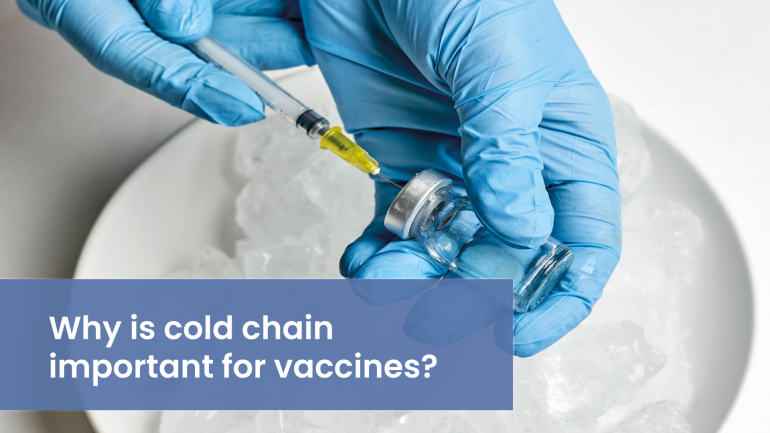Why is the cold chain important for vaccines?

A virus or even a pandemic has serious consequences all over the world. Something we currently all experience during the COVID-19 pandemic. One virus has the power to shut down whole societies, it destroys economies and impacts the health of many. Therefore many pharmaceutical companies quickly developed vaccines to collectively battle the virus. To be able to get populations all over the world protected against the virus, the vaccine needs to be distributed safely. When we talk about distributing vaccines, you often hear about a cold chain. It is a necessary element for transporting and distributing vaccines. Within a country or to the injection site, but also for moving the vaccines overseas. But what is the cold chain? And why is it so important for transporting vaccines? In this article, we share why it is important to facilitate a cold chain for vaccines.
What is cold chain?
Let us start at the beginning: what is a cold chain? Cold chain is a supply chain that is temperature-controlled. The ideal temperature for the product that is produced, transported, and distributed is fairly low. Therefore the product needs to be refrigerated and the temperature needs to be controlled throughout the logistics as well. Cold chain for vaccines is a set of procedures and rules that ensure safe storage and distribution of the vaccines. The purpose of a cold chain is to maintain the quality of the product from the moment it is manufactured, until the moment the product is used. In this case the vaccines.
What makes cold chain important for the distribution of vaccines?
Often vaccines are biological products which means that they are sensitive to temperature changes, heat, and light. The quality of the vaccine stabilizes when it is kept in a colder environment. Therefore, the purpose of the cold chain is to secure the quality and condition of the product. Once the vaccine is lost, it is impossible to regain. This makes the cold chain essential in the battle against many viruses, like for example the current COVID-19. To be able to fight the virus, the distribution needs to be thought-through and refined.
What are the perfect cold chain temperatures for vaccines?
For everyone who handles the distribution of vaccines, or wants to contribute to this chain somehow, it is important to delve into the best cold chain temperatures. There are some national guidelines drawn up for the storage of different types of vaccines. Most vaccines need to be stored at a temperature between +2°C and +8°C. Other vaccines need to be frozen and are kept under temperatures of -70°C. But in the end, it is the manufacturer who knows the product best and who specifies the cold chain requirements. It is important to follow their regulations.
At what temperature do COVID-19 vaccines need to be stored?
Let us take some current COVID-19 vaccines for example. The manufacturer Pfizer-BioNTech created a vaccine that requires a storage temperature of -80°C to -60°C. This makes transporting a big task. When the vaccine is diluted, it needs to be stored between 2°C and 8°C where it will only stay in good quality for a maximum of 6 hours. One of the biggest competitors at the moment is the vaccine manufacturer Oxford-AstraZeneca. This vaccine requires a temperature of 2°C to 8°C and can not be frozen.
How does cold chain transportation of frozen vaccines work?
After producing the vaccines, the product is firstly stored in big freezers that have the capability of freezing up to -80°C. Fun fact, your freezer in the kitchen freezes up to -18°C. A manufacturer distributes the vaccines to many different locations. Sometimes the vaccines are even transported between continents. Therefore, cold chain management gets even more important. The first steps are distributing the vaccines to the country or area where it is needed. But how do you transport a vaccine across borders, without losing it? For the Pfizer vaccine that needs to be stored at a temperature of -70°C, dry ice is a solution. This is a solid form of CO₂ or carbon dioxide that is used for cooling. When packed into hermetically sealed boxes, the product stays cold for a fair amount of time. The problem is that once the box is opened, the temperature drops substantially. In addition, transporting large quantities of CO₂ in an airplane does come with some risks.
How does cold chain distribution work for cooled vaccines?
When the vaccine needs to be stored at a regular temperature (2°C to 8°C) the best and most safe option is transporting the vaccine in EPS boxes. EPS boxes are well-isolated boxes made of styrofoam. EPS is perfect for transporting medical and pharmaceutical objects since the material is hygiënic and insensitive to moisture, UV radiation, and fungi. For securing the temperature within transport boxes you can use various products to keep the vaccines at the right temperature during transport, such as gel packs and ice packs. Cooling products like these help to maintain a steady temperature. Besides that, the ice packs or gel packs take up less space and also weigh less, which reduces the transport costs in general. The use of ice packs is also easy. Store them at -20 degrees to make sure it is thoroughly cooled. When the cooling solution is needed, take them out of the freezer. Let the ice packs acclimate and wait for the white frost to faint before placing them in the cooling boxes.
Transporting vaccines in the Netherlands? Make sure you read the governmental guidelines for vaccine management. In need of cold chain cooling solutions? Feel free to contact us for advice!


